Strawberry IPM Newsletter No. 4 – June 5, 2020
Strawberry IPM Newsletter No. 4 – June 5, 2020
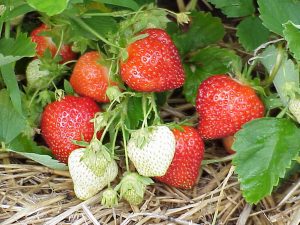
Click on photos to enlarge
LATE SEASON FROSTS THREATEN STRAWBERRY BLOSSOMS
Spider Mites and Bacterial Angular Leaf Spot Found in Blooming Fields
Twilight Meeting Tuesday June 16th at 6:30pm at Blackie’s Farm Fresh Produce in Auburn
Situation:
A plague of late frost events around the state over the past two weeks, has threatened and in some cases, significantly damaged strawberry buds and blossoms. Growers who were able to apply timely irrigation for frost protection saw little damage. However, many fields have lots of black-centered flowers, indicating that they have succumbed to the freezing temperatures. There is evidence to suggest that when some blossoms are killed on a strawberry’s flower cluster, the surviving flowers will compensate, either by increased size or the number that successfully develop to marketable quality berries, so that the impact on total yield may not be as great. Early fields in southern Maine now have green berries, with a little color showing on beds that were under rowcovers. Further north, later fields are mostly in full bloom or just beyond, with the exception of very late varieties, such as Malwina.
Strawberry bud weevil or “clipper”:
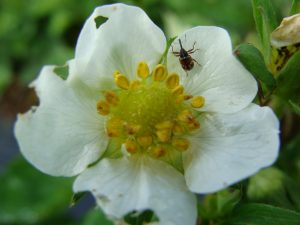
Bloom in most fields in the southern and mid-state regions are now beyond the point where clippers could cause significant damage. A few clipped buds were found along the edges of late blooming fields, but not enough to require control. It appears that clippers did not pose much of a threat this year, probably a result of its late emergence and the rapid development of strawberry buds over the past two weeks. Clippers will likely move on to attack the buds of raspberries and blackberries over the next few weeks, but they do not usually cause significant injury on these crops.
Tarnished plant bug:
A few more tarnished plant bug nymphs were found in
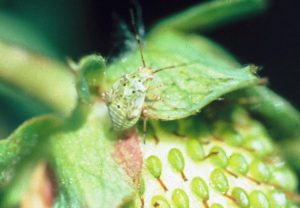
blooming fields this week, but not in high enough numbers to warrant control measures. Feeding by these insects can cause misshapen fruit until a few days beyond petal fall, so it is important to keep scouting for them as their numbers can increase very quickly with warm weather. The threshold for plant bug nymphs is 4 or more flower clusters infested with nymphs per 30 sampled.
Two-spotted spider mites:
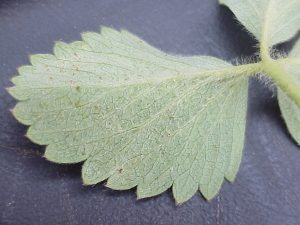
Spider mites continue to be a problem in most fields this spring, despite early efforts to control them. Although, I have not been finding high concentrations of mites on single leaves, the wide distribution of mites throughout the fields poses a significant threat, because the population can increase very rapidly under warm, dry conditions. So, it is important to scout for them regularly. If 25% of leaves sampled (e.g. 15 out of 60) have any mites, a spray should be applied. Chemical control options for two-spotted spider mites include Acramite®, Savey®, Zeal®, Portal®, Vendex®, Oberon®, Brigade®, and Danitol®. An additional strategy is to release predatory mites into the fields to help suppress the spider mites. This might be most effective following renovation, when the new foliage emerges, to keep spider mite populations low going into the winter.
Spittlebugs:
The first spittlebugs of the season were found this week. The frothy spittle masses appear on both leaf stems and flower stems, starting right around bloom. Although spittlebugs don’t pose a significant threat to the plants, the frothy spittle masses they cover themselves with creates an annoyance for pickers. Adult spittlebugs are about ¼ inch long and bright green when they first emerge, but later turn dull yellow or brown. Spittlebugs tend to be a greater problem in weedy fields. Pesticides currently registered for spittlebug control include Provadoâ, Danitolâ and Brigadeâ.
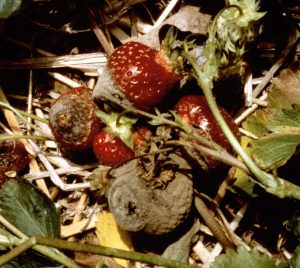
Diseases:
Gray mold (Botrytis) is still an important threat to strawberry fruit at this time. Growers have been irrigating to both relieve dry soil conditions and to protect against frost. As a result, the plants have been wet for extended periods of time, creating ideal conditions for gray mold infection of the flowers. Flowers should continue to be protected against infection with fungicide sprays if more than one inch of water, either from rainfall or irrigation, has fallen on the field since the last fungicide application.
Angular leaf spot:
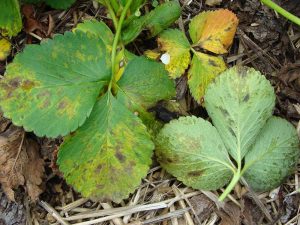
This bacterial disease was found in one field this week. It is characterized by translucent leaf spots that turn yellow and eventually black. The symptoms tend to start on the lower leaves, then move upwards as bacterial spores are splashed up by rain or irrigation water. Infection of the calyxes causes blackening of the berry stems and caps, reducing their marketability. Bacterial angular leaf spot is favored by extended cool, wet weather with temperatures close to freezing. Frequent irrigation for frost protection encourages the development and spread of this disease. The copper-containing material Kocide®, can reduce the spread of this disease, but must be applied prior to bloom. Application of copper sprays after bloom can result in fruit injury and is not recommended. Hydrogen dioxide (OxiDate®) may also have some activity against angular leaf spot when used on strawberries as part of a gray mold management program.
Leather rot (Phytopthora cactorum) is a concern for strawberry growers this year. This disease is often a problem when we have long stretches of standing water in the fields during bloom and fruit development. Spores are splashed up by the rain and infect flowers and fruit, causing them to develop off colors and bad flavor. Sunken black lesions on the fruit may also be visible. Applying straw mulch between the rows to prevent berries from touching the soil and reducing soil splashing onto the berries can reduce infections. Foliar sprays of Aliette®, Prophyt® or Phostrol® applied during bloom and fruit development can help prevent leather rot.
Powdery mildew:
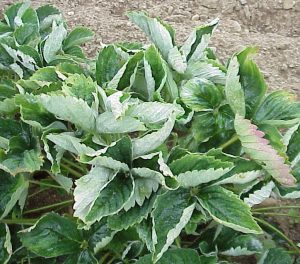
More fields were showing symptoms of powdery mildew this week, with upward cupping of the leaves and reddish streaking on the leaf and flower stems. This disease will likely become more prevalent as the season progresses. When applying fungicides to control gray mold, consider using a product that will also control powdery mildew, such as captan + Topsin-M®, or Pristine®.
Other Berries:
Highbush blueberries are in bloom or starting fruit development. There may have been localized frost damage in some plantings, which can kill blossoms or damage developing fruit. Fungal infections from Anthracnose and Botrytis can cause twig blights and result in fruit infections during bloom. See the New England Small Fruit Management Guide for descriptions and management details.
Raspberries are beginning to bloom in southern Maine. Gray mold infections can occur throughout the bloom period, so recommended fungicides should be applied either before or just after any significant wetting event, e.g. rain or overhead irrigation. Spur blight is another fungal disease, which attacks the cane, causing purple lesions on the primocanes and often killing the axillary buds that produce fruit next year. Good pruning practices to promote drying, and recommended fungicides, including captan and Tanosâ, can help control this disease.
Reminder: Twilight Meeting Tuesday June 16th at Blackie’s Farm Fresh Produce, 966 Minot Ave., Auburn, starting at 6:30 p.m. One pesticide applicator recertification credit will be awarded for the meeting. See you there!
COVID-19 information for farmers: For information regarding growing and marketing crops under COVID-19 restrictions please visit our webpage:
Additional Resources During COVID-19
The most up-to-date version of the New England Small Fruit Management Guide is available online.
Remember, for pest management questions you can access this guide online at: UMass (NE Small Fruit Management Guide).
Sincerely,
David T. Handley
Vegetable and Small Fruit Specialist
Highmoor Farm Pest Mgmt. Unit
P.O. Box 179 17 Godfrey Drive
52 U.S. Route 202 Orono, ME 04473
Monmouth, ME 04259 1.800.287.0279
207.933.2100
The University of Maine is an equal opportunity/ affirmative action institution.
Where brand names or company names are used, it is for the reader’s information. No endorsement is implied nor is any discrimination intended against other products with similar ingredients. Always consult product labels for rates, application instructions and safety precautions. Users of these products assume all associated risks.
